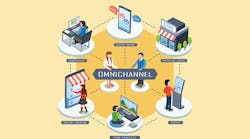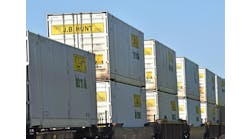While 71% of CEOs of consumer goods companies cite omni-channel fulfillment as a top priority for future investment, only 19% of the top 250 retailers are currently fulfilling omni-channel demand profitably, according to a new study by JDA.
The third annual Walker Sands Future of Retail Report, offers insight into consumer attitudes towards different aspects of retail, including the growing importance of the supply chain.
Key findings include:
- Nearly a third of consumers (31%) now shop online at least once a week, an increase of 41% from two years ago.
- Only 9% of consumers have used same-day shipping in the past year, but almost half (49%) say same-day shipping would make them shop more online if it were offered more frequently.
- 40% of consumers expect to receive their first drone-delivered package in the next two years or less. Less than a third (31%) think it will take more than five years.
- Among consumers who don’t trust drones to deliver packages, theft and damaged packages are the top concerns (72% each), but safety (68%) and privacy (60%) seem less risky than they were a year ago.
Growing Importance of the Supply Chain
Over the past three years, findings have shown that seamless shipping, delivery and returns have become more and more important to consumers, making them primary future drivers of e-commerce growth. According, fulfillment has become a top investment area for retailers, with 29% of capital expenditures last year going toward solutions like transportation and logistics, delivery options, order management, inventory visibility and returns management.
Speed of Supply Chain Matters More to Frequent Online Shoppers
Free shipping continues to be the top incentive, with almost nine in 10 consumers reporting that free shipping would make them shop more online. This number has steadily increased over the past two years and has become significantly more influential than other logistics considerations, even as same-day shipping becomes more prominent. One-day shipping (69%) and free returns (68%) also continue to be top drivers.
The biggest jump over the past three years has been easier online returns, 58% saying a simpler process could make them shop more online.
While nearly half of consumers (49%) say same-day shipping would make them shop more online, it appears that relatively few are being given the option. Only one in 10 consumers (9%) have used same-day shipping in the past year, compared to 29% for one-day shipping, 70% for two-day shipping and 86 percent for regular shipping. More than half (51%) say they have placed an order online and picked it up in store, which speaks to the rising popularity of click and collect.
While free shipping continues to be a top incentive, it’s now a given across the board, with no meaningful statistical difference in expectations between consumers who shop online multiple times a year and those who make web purchases only a couple times a year. But as consumers shop online more frequently, they are increasingly persuaded by the speed of the supply chain.
As Amazon and third-party logistics providers make infrastructure improvements that lead to more efficient inventory management, fulfillment and delivery practices, consumer expectations continue to rise, especially among frequent online shoppers. In fact, consumers who shop online more than twice a week are twice as likely to be persuaded by same-day shipping as consumers who shop online only a few times a year (63% vs. 32%).
Integration of In-Store and Online Experiences
While e-commerce is now a routine part of consumers’ lives, this year’s study reveals there’s still a clear preference to shop in physical stores for most product categories, but a receptiveness to blending the online and brick-and mortar experiences. While less than a third of retailers had implemented beacon technology in 20152, we found that seven in 10 consumers would be willing to opt into in-store tracking and mobile push notifications if they were properly incentivized by retailers. Although beacons have been slow to take off, this area seems ripe for adoption as retailers like Macy’s, Target and Lord & Taylor roll out their beta beacon programs to the masses. And in a case of bringing the in-store experience online, virtual reality e-commerce – or v-commerce – seems to be entering the early-adoption phase and could
represent the next big integration area for the in-store and online shopping experiences.
Slow Mobile Payments Adoption
Privacy and security concerns remain the primary reasons that consumers are hesitant to use mobile payment applications. This could explain why adoption has essentially remained flat year over year, with about a third of consumers having used these applications. Still, U.S. mobile payment transactions are expected triple in 2016 to $27 billion, a sign that a few eager early adopters and the growth of Apple Pay could eventually force more widespread changes in consumer behavior.
The future of retail hasn’t plateaued; we’re simply in an investment and adoption phase during which retailers’ practices and consumer behavior hasn’t caught up with technology. As a result, this year’s study is much more pragmatic than visionary, focusing on practical recommendations over aspirational technology.



